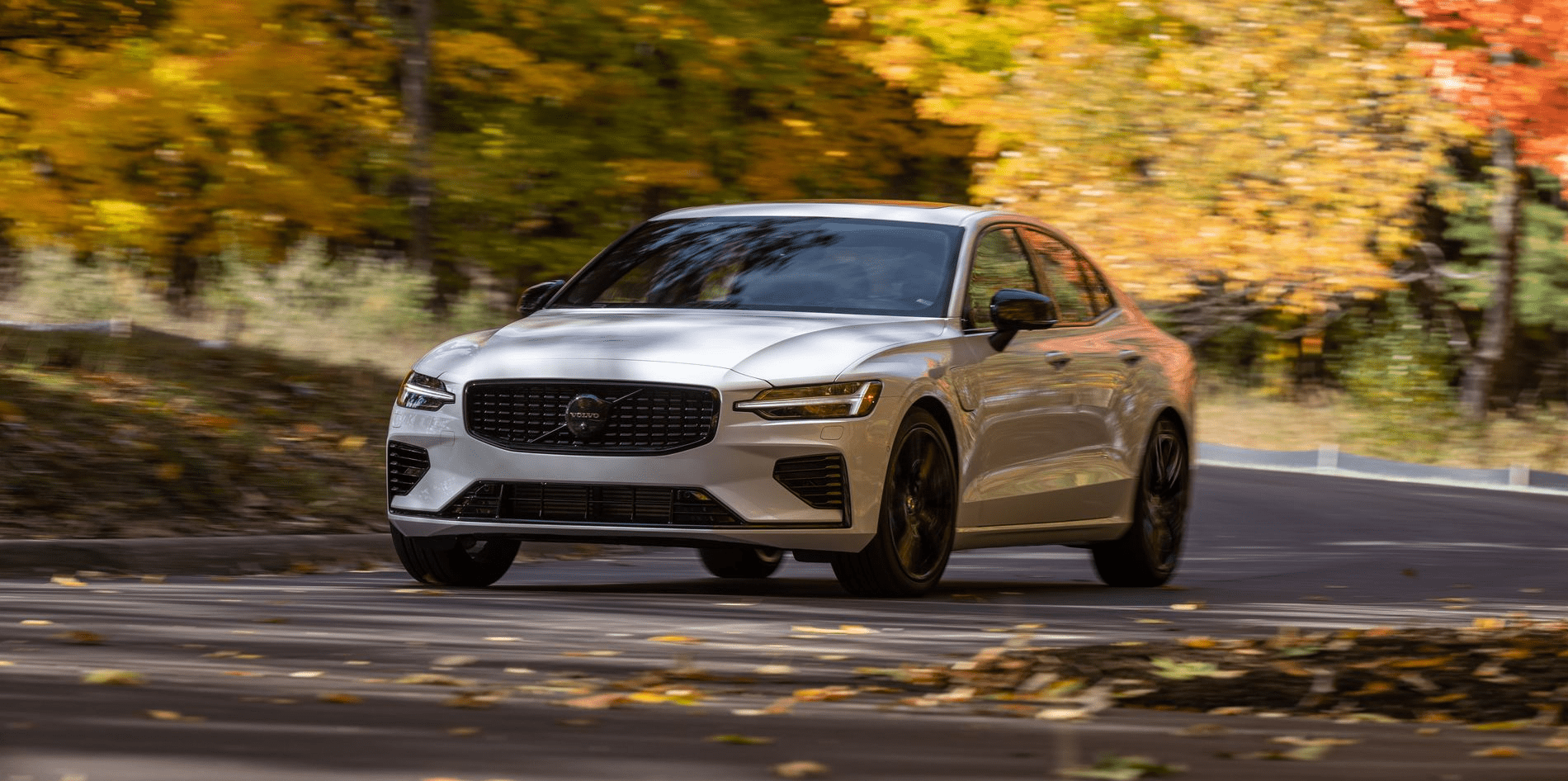Volvo S60 2021-2023 Safety User Manual
Introduced for model years 2021 through 2023 is the Volvo S60, a sedan with a strong focus on safety. It has a number of high-tech features that are meant to boost driver trust and keep passengers safe. Volvo is known for its dedication to safety innovation, and the S60 is a great example of this. It has a full suite of cutting-edge safety technologies that make driving safe and comforting. The Volvo S60 has a number of features that help the driver, such as automatic emergency braking, collision avoidance aid, adaptive cruise control, and lane departure warning. These features are meant to prevent accidents and make them less likely to happen. Also, safety features like blind-spot tracking, pedestrian detection, and rear cross-traffic alert add to the vehicle’s safety cocoon. The S60 also has technology advances like City Safety, which helps the car find pedestrians, cyclists, and other vehicles and can automatically apply the brakes if needed. Adaptive headlights make it easier to see at night, and kid safety features, airbags, and built-in booster seats put the safety of all passengers, including children, first. The Volvo S60 2021–2023 has a strong commitment to active safety that goes beyond its appearance. It is a great example of how innovation, engineering excellence, and a strong commitment to passenger safety can work well together. So, the S60 is a good example of how Volvo is always trying to set new standards for safety in the auto business.
Safety
The vehicle is equipped with several safety systems that work together to protect the vehicle’s driver and passengers in the event of an accident.
The car is equipped with a number of sensors that react in the event of an accident and activate different safety systems, such as different types of airbags and seatbelt tensioners. Depending on the specific accident situation, such as collisions at different angles, roll-over,s or driving off the road, the systems react in different ways to provide good protection.
There are also mechanical safety systems such as Whiplash Protection System. The car is also constructed so that a large part of the force of a collision is distributed to beams, pillars, floor, roof and other parts of the body. The car’s safety mode may be activated after a collision if an important function in the car has been damaged.
Warning Symbol in Driver Display
The warning symbol is illuminated in the driver display when the car’s electrical system is set in ignition position II. The symbol is extinguished after approx. 6 seconds if the car’s safety system is fault-free.
WARNING
If the warning symbol remains illuminated or is switched on during driving and the message SRS airbag Service urgent Drive to workshop is shown in the driver display, it means that part of one of the safety systems does not have full functionality. Volvo recommends that an authorized Volvo workshop should be contacted as soon as possible.
WARNING
Never modify or repair the car’s various safety systems yourself. Defective work in one of the systems can cause malfunction and result in serious personal injury. Volvo recommends that an authorized Volvo workshop should be contacted.
If the specific warning symbol is broken then the general warning symbol is illuminated instead and the driver display shows the same message.

Related Information
- Safety during pregnancy (p. 47)
Seatbelts (p. 50)
Airbags (p. 55)
Whiplash Protection System (p. 47)
Pedestrian Protection System (p. 49)
Safety mode (p. 61)
Safety During Pregnancy
It is important that the seatbelt is used correctly during pregnancy, and that pregnant drivers adjust their seating position.
Seatbelt
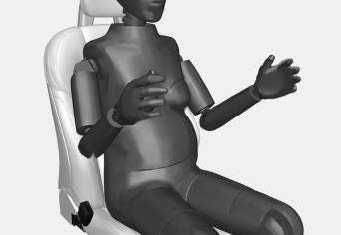
The diagonal section should wrap over the shoulder then be routed between the breasts and to the side of the abdomen.
The lap section should lay flat over the thighs and as low as possible under the abdomen. It must never be allowed to ride upward. Remove the slack from the seatbelt and ensure that it fits as close to the body as possible. In addition, check that there are no twists in the seatbelt.
Seating Position
As the pregnancy progresses, pregnant drivers must adjust the seat and steering wheel such that they can easily maintain control of the vehicle as they drive (which means that they must be able to easily operate the foot pedals and steering wheel). The aim should be to position the seat with as large a distance as possible between abdomen and steering wheel.
Related Information
Whiplash Protection System
Whiplash Protection System (WHIPS) reduces the risk of whiplash injuries. The system consists of energy absorbing backrests and seat cushion, as well as a specially designed head restraint in the front seats. WHIPS is deployed in the event of a rear-end collision, where the angle and speed of the collision and the nature of the colliding vehicle all have an influence.
When WHIPS is deployed, the front seat backrests are lowered backward and the seat cushions move downward to change the seating position of the driver and front seat passenger. Its movement helps to absorb some of the forces that can arise and cause whiplash.
WARNING
WHIPS is a supplement to the seatbelts. Always use a seatbelt.
WARNING
Never modify or repair the seat or WHIPS yourself. Volvo recommends that an authorized Volvo workshop should be contacted.
If the front seats have been subjected to a major load, such as in conjunction with a collision, the seats must be replaced. Some of the seats’ protective properties may have been lost even if they do not appear damaged.

Do not leave any objects on the floor behind or under the front seats or in the rear seat that may prevent WHIPS from functioning.
WARNING
Do not squeeze rigid objects between the rear seat cushion and the front seat’s back-rest.
If a backrest in the rear seat is lowered then any load must be secured to prevent it from sliding up to the front seat backrest in the event of a collision.
WARNING
If a backrest in the rear seat is lowered or a rear-facing child seat is used in the rear seat, the corresponding front seat must be moved forward so that it does not make contact with the lowered backrest or child seat.
Seating Position
For good protection from WHIPS the driver and passenger must have the correct seating position and make sure that the system’s function is not obstructed.
Set the correct seating position in the front seat before driving starts.
Driver and front seat passenger should sit in the center of the seat with as little space as possible between the head and the head restraint.
WHIPS and Child Seats
The protection provided by the car to children seated in a child seat or on a booster cushion is not diminished by WHIPS.
Related information
Pedestrian Protection System
The Pedestrian Protection System (PPS) is a system which, in certain frontal collisions, contributes to mitigating a pedestrian’s impact with the car.
In certain frontal collisions with a pedestrian, the sensors in the front of the car react and the system is activated.
When PPS is activated, the following occur:
- The rear section of the bonnet is raised.
- An automatic alarm is sent via Volvo On Call*.
The sensors are active at a speed of approx. 25-50 km/h (15-30 mph).
The sensors are designed to detect a collision with an object that has similar properties to those of the human leg.
NOTE
There may be objects in the traffic environment that prompt a signal to the sensors that is similar to a collision with a pedestrian. It is possible that the system will be activated in the event of a collision with such an object.
WARNING
Do not fit any accessories or change any-thing in the front. Incorrect intervention at the front may cause incorrect function in the system and lead to serious injury and damage to the car.
Volvo recommends that genuine wiper arms are used and that only genuine parts are used for them.
WARNING
Never modify or repair the system yourself. Volvo recommends that an authorized Volvo workshop should be contacted. Defective work in the system could cause malfunction and result in serious personal injury.
WARNING
Volvo recommends contacting an authorized Volvo workshop in the event of any damage to the front of the car in order to ensure that the system is intact.
Symbols in the driver display
Symbol

Specification
PPS has been activated, or a fault has occurred in the system. Follow the recommendation given.
Related Information
Safety (p. 46)
Seatbelts
Heavy braking can have serious consequences if the seatbelts are not used.
It is important that the seatbelt lies against the body so it can provide good protection. Do not lean the backrest too far back. The seatbelt is designed to protect in a normal seating position.
WARNING
Remember not to clip or hook the seatbelt to hooks or other interior fittings, as this prevents the belt from tightening properly.
WARNING
The seatbelts and airbags interact. If a seatbelt is not used or is used incorrectly, this may diminish the protection provided by the airbag in the event of a collision.
WARNING
Never modify or repair the seatbelts your-self. Volvo recommends that an authorised Volvo workshop should be contacted.
If the seatbelt has been subjected to a major load, such as in conjunction with a collision, the entire seatbelt must be replaced. Some of the seatbelt’s protective properties may have been lost even if the seatbelt does not appear damaged. The seatbelt must also be replaced if it shows signs of wear or damage. The new seatbelt must be type-approved and designed for installation at the same location as the replaced seatbelt.
Related Information
- Safety (p. 46)
Seatbelt tensioner (p. 52)
Putting on and taking off seatbelts (p. 50)
Door and seatbelt reminder (p. 53)
Putting on and Taking off Seatbelts
Make sure that all passengers have fastened their seatbelts before starting to drive.
Putting on Seatbelts
- Pull out the seatbelt slowly and make sure it is not twisted or damaged.
NOTE
The seatbelt is equipped with an inertia reel that is locked in the following situations:- If the belt is extended too quickly.
- During braking and acceleration.
- If the car leans heavily.
- When driving in bends.
- Lock the belt by inserting the locking tab in the intended buckle.
- A loud “click” indicates that the belt has locked.
WARNING
Always insert the tongue of the seatbelt into the buckle on the correct side. The seatbelts and buckles would otherwise possibly not function as intended in the event of a collision. There is a risk of serious injury.
- A loud “click” indicates that the belt has locked.
- In the front seats the seatbelt can be adjusted for height.
 Press together the seat mounting and move the seatbelt up or down.
Press together the seat mounting and move the seatbelt up or down.
Position the belt as high as possible without it chafing against your throat. The seatbelt must pass over the shoulder (not down over the arm).
The seatbelt must pass over the shoulder (not down over the arm). - Tension the hip strap over the lap by pulling the diagonal shoulder belt up towards the shoulder.
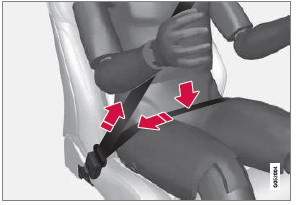
The hip strap must be positioned low down (not over the abdomen).
WARNING
Each seatbelt is designed for only one person.
WARNING
Remember not to clip or hook the seatbelt to hooks or other interior fittings, as this prevents the belt from tightening properly.
WARNING
Do not make any damages on seatbelts nor insert any foreign objects into a buckle. The seatbelts and buckles would then possibly not function as intended in the event of a collision. There is a risk of serous injury.
Taking off seatbelts
- Press the red button on the seatbelt buckle and then let the belt retract.
- If the seatbelt does not retract fully, feed it in by hand so that it does not hang loose.
Related Information
Seatbelt Tensioner
The car is fitted with standard seatbelt tensioners and electric* seatbelt tensioners that can tension the seatbelts in critical situations and collisions.
Standard seatbelt tensioner
All the seatbelts are equipped with a standard seatbelt tensioner.
The seatbelt tensioner tensions the seatbelt in the event of a collision with sufficient force in order to more effectively restrain the occupant.
Electric seatbelt tensioner*
The driver and front passenger seatbelts are equipped with an electric seatbelt tensioner.
The seatbelt tensioners work together and can be activated together with the driver support systems City Safety and Rear Collision Warning. In critical situations, such as panic braking, driving off the road (e.g. the car rolls into a ditch, lifts off the ground or hits some-thing in the terrain), skidding, or risk of collision, the seatbelt can be tensioned by the seatbelt tensioner’s electric motor.
The electric seatbelt tensioner helps to adjust the occupant to a better position, reducing the risk of striking the car’s interior and improving the effect of safety systems, such as the car’s airbags.
When the critical situation has come to an end, the seatbelt and the electric seatbelt pre-tensioner are restored automatically, but they can also be restored manually.
IMPORTANT
If the passenger airbag is deactivated, the electric seatbelt tensioner on the passenger side will also be deactivated.
WARNING
Never modify or repair the seatbelts your-self. Volvo recommends that an authorised Volvo workshop should be contacted.
If the seatbelt has been subjected to a major load, such as in conjunction with a collision, the entire seatbelt must be replaced. Some of the seatbelt’s protective properties may have been lost even if the seatbelt does not appear damaged. The seatbelt must also be replaced if it shows signs of wear or damage. The new seatbelt must be type-approved and designed for installation at the same location as the replaced seatbelt.
Related Information
- Seatbelts (p. 50)
- Putting on and taking off seatbelts (p. 50)
- Resetting the electric seatbelt tensioner* (p. 53)
- Activating and deactivating passenger air-bag* (p. 58)
- City Safety™ (p. 352)
Rear Collision Warning* (p. 372)
Resetting the Electric Seatbelt Tensioner*
The electric seatbelt tensioner is designed to be reset automatically, but the seatbelt tensioner can be reset manually if the belt remains extended.
- Stop the car at a safe place.
- Unfasten the seatbelt and then refasten it.
- The seatbelt and electric seatbelt tensioner are reset.
WARNING
Never modify or repair the seatbelts yourself. Volvo recommends that an authorized Volvo workshop should be contacted.
If the seatbelt has been subjected to a major load, such as in conjunction with a collision, the entire seatbelt must be replaced. Some of the seatbelt’s protective properties may have been lost even if the seatbelt does not appear damaged. The seatbelt must also be replaced if it shows signs of wear or damage. The new seatbelt must be type-approved and designed for installation at the same location as the replaced seatbelt.
Door and Seatbelt Reminder
The system reminds unbelted occupants to wear a seatbelt, and also warns about an open door, bonnet or lid.
Driver Display Graphics
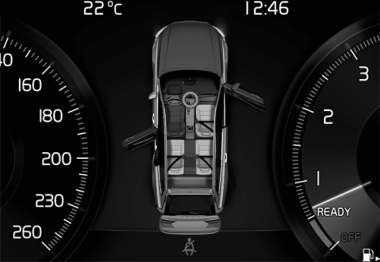
Graphics in the driver display with different types of warnings. The warning color on the door and boot lid is dependent on the speed of the car.
The driver display’s graphics show which seats in the car are occupied by belted and unbelted passengers.
The same graphic also shows if the bonnet, boot lid or any door is open.
The graphic can be acknowledged by pressing the O button on the right-hand steering wheel keypad.
- Seatbelt Reminder
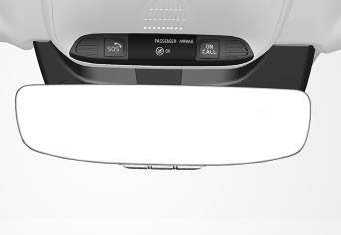
Visual reminder in the roof console.
A visual reminder is given in the roof console and by means of the warning symbol in the driver display.
The acoustic reminder is dependent on speed, driving time and distance.
The belt status of the driver and passengers is shown in the driver display’s graphic when a belt is buckled or unbuckled.
Child seats are not covered by the seatbelt reminder system.
Front Seat
A visual and acoustic reminder remind the driver and front seat passenger to use a seat-belt if either of them is not wearing one.
Rear Seat
The seatbelt reminder in the rear seat has two sub functions:
- Provides information on which seatbelts are being used in the rear seat. The driver display’s graphics are shown when the seatbelts are in use.
Reminding that a seatbelt in the rear seat is unfastened during a journey by means of a visual and acoustic reminder. The reminder will cease once the seatbelt has been put on again.
Reminder for Doors, Bonnet, Boot Lid and Fuel Filler Flap
If the bonnet, boot lid, fuel filler flap or any door is not closed properly, the graphic in the driver display shows what is open. Stop the car in a safe place as soon as possible and close the source of the warning.
If the car is driven at a speed lower than approx. 10 km/h (6 mph) then the driver display’s information symbol illuminates.
If the car is driven at a speed higher than approx. 10 km/h (6 mph) then the driver display’s warning symbol illuminates.
Related Information
Airbags
The car is equipped with airbags and inflatable curtains for driver and passengers.
NOTE
The detectors react differently depending on the nature of the collision and whether or not the seatbelts are fastened. Applies to all belt positions.
It is therefore possible that only one (or none) of the airbags may inflate in a collision. The detectors sense the force of the collision on the vehicle and the action is adapted accordingly so that none, one or more airbags are deployed.
WARNING
The airbag system’s control module is located in the center console. If the center console is drenched with water or other liquid, disconnect the cables to the starter battery. Do not attempt to start the car since the airbags may deploy. Recovering the car. Volvo recommends that it is trans-ported to an authorized Volvo workshop.
Deployed Airbags
If any of the airbags have deployed, the following is recommended:
- Recovering the car. Volvo recommends that it is transported to an authorized Volvo workshop. Do not drive with deployed airbags.
- Volvo recommends engaging an authorized Volvo workshop to handle the replacement of components in the car’s safety systems.
Always contact a doctor.
WARNING
Never drive with deployed airbags. They can make steering difficult. Other safety systems may also be damaged. The smoke and dust created when the airbags are deployed can cause skin and eye irritation/injury after intensive exposure. In case of irritation, wash with cold water. The rapid deployment sequence and airbag fabric may cause friction and skin burns.
Related Information
- Safety (p. 46)
Driver airbags (p. 55)
Passenger airbag (p. 56)
Side airbags (p. 60)
Inflatable curtains (p. 61)
Driver Airbags
As a supplement to the seatbelts, the car is equipped with steering wheel airbag and knee airbag1 on the driver’s side.
Steering wheel airbag and knee airbag1 on the driver’s side in the front seat.
In the event of a frontal collision, the airbags help to protect the head, neck, face and chest of the driver as well as the knees and legs.
A sufficiently violent collision trips the sensors and the airbag/airbags is inflated. The airbag cushions the initial collision impact for the occupant. The airbag deflates when com-pressed by the collision. When this occurs, smoke escapes into the car. This is completely normal. The entire process, including inflation and deflation of the airbag, occurs within tenths of a second.
WARNING
The seatbelts and airbags interact. If the belt is not used or is used incorrectly, this may diminish the protection provided by the airbag in the event of a collision.
To minimize the risk of injury if the airbag deploys, passengers must sit as upright as possible with their feet on the floor and backs against the backrest.
WARNING
Volvo recommends that an authorized Volvo workshop should be contacted for repair. Defective work in the airbag system could cause malfunction and result in serious personal injury.
Steering Wheel Airbag Location
This airbag is fitted into the center of the steering wheel. The steering wheel is marked AIRBAG.
Knee Airbag1 Location
The airbag is folded up in the lower part of the instrument panel on the driver’s side. Its cover panel is marked AIRBAG.
WARNING
Do not place or attach any object on the top or front of the panel where the knee airbag is stowed.
Related Information
Passenger airbag
As a supplement to the seatbelts, the vehicle is equipped with an airbag on the passenger side in the front seat.
Passenger Side Front Airbag.
In the event of a frontal collision, the airbag helps to protect the head, neck, face and chest of the passenger as well as the knees and legs.
A sufficiently violent collision trips the sensors and the airbag is inflated. The airbag cushions the initial collision impact for the occupant. The airbag deflates when compressed by the collision. When this occurs, smoke escapes into the car. This is completely normal. The entire process, including inflation and deflation of the airbag, occurs within tenths of a second.
WARNING
The seatbelts and airbags interact. If the belt is not used or is used incorrectly, this may diminish the protection provided by the airbag in the event of a collision.
To minimize the risk of injury if the airbag deploys, passengers must sit as upright as possible with their feet on the floor and backs against the backrest.
WARNING
Volvo recommends that an authorized Volvo workshop should be contacted for repair. Defective work in the airbag system could cause malfunction and result in serious personal injury.
Passenger Airbag Location
The airbag is folded up into a compartment above the glovebox. Its cover panel is marked AIRBAG.
WARNING
Do not put objects in front of or above the dashboard where the passenger airbag is located.
Label for Passenger Airbag
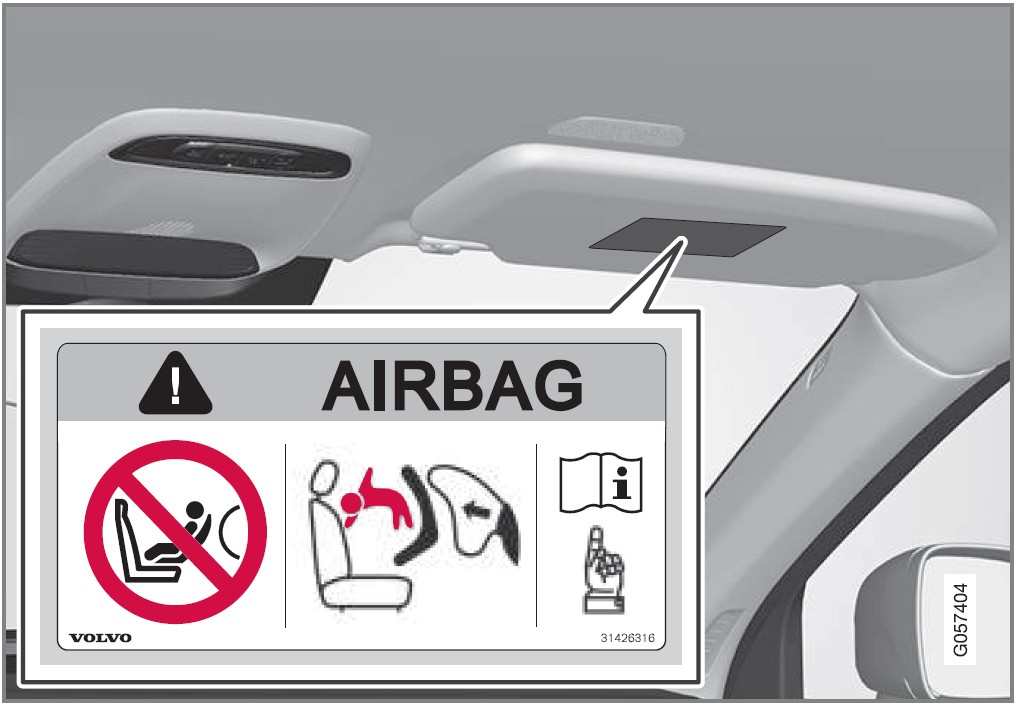
- Label on the passenger side’s sun visor.
The warning label for the passenger airbag is positioned as shown above. - WARNING
If the car is not equipped with a switch to activate/deactivate the passenger airbag, the airbag will always be activated.
WARNING
Never allow anybody to stand or sit in front of the front passenger seat.
Never use a rear-facing child seat on the front passenger seat if the airbag is activated.
Front-facing passengers (children and adults) must never sit on the front passenger seat if the passenger airbag is deactivated.
Failure to follow the advice given above can endanger life or lead to serious personal injury.
Related Information
Activating and Deactivating Passenger Airbag*
The passenger airbag can be deactivated if the car is equipped with a switch, Passenger Airbag Cut Off Switch (PACOS).
The switch for the passenger airbag is located on the passenger end of the instrument panel and is accessible when the passenger door is open.
Check that the switch is in the required position.
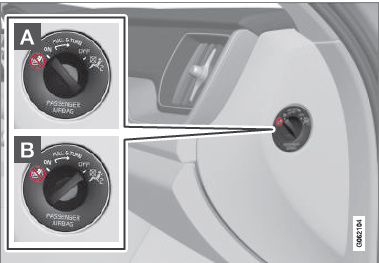
ON – The airbag is activated and all front-facing passengers (children and adults) can sit safely on the passenger seat.
OFF – The airbag is deactivated and children in rear-facing child seats can sit safely on the passenger seat.
WARNING
If the car is not equipped with a switch to activate/deactivate the passenger airbag, the airbag will always be activated.
Activating Passenger Airbag
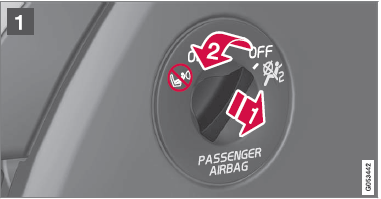
- Pull the switch outward and turn from OFF to ON.
The driver display shows the message Passenger airbag on Please acknowledge.
NOTE
If the passenger airbag has been activated/deactivated with the car in ignition position I or lower, a message is shown in the driver display and the following indicator in the roof console approx. 6 seconds after the car’s electrical system has been set in ignition position II. - Confirm the message by pressing the right-hand steering wheel keypad’s O button.
- A text message and a warning symbol in the roof console indicate that the air-bag for the front passenger seat is activated.
WARNING
Never use a rear-facing child seat on the front passenger seat when the airbag is activated.
The passenger airbag must always be activated when front-facing passengers (children and adults) are sitting in the front passenger seat.
Failure to follow the advice given above can endanger life or lead to serious personal injury.
Deactivating Passenger Airbag
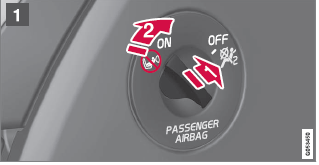
- Pull the switch outward and turn from ON to OFF.
- The driver display shows the message Passenger airbag off Please acknowledge.
NOTE
If the passenger airbag has been activated/deactivated with the car in ignition position I or lower, a message is shown in the driver display and the following indicator in the roof console approx. 6 seconds after the car’s electrical system has been set in ignition position II.
- The driver display shows the message Passenger airbag off Please acknowledge.
- Confirm the message by pressing the right-hand steering wheel keypad’s O button.
- A text message and a symbol in the roof console indicate that the airbag for the front passenger seat is deactivated.
WARNING
Front-facing passengers (children and adults) must never sit on the passenger seat when the airbag is deactivated.
Failure to follow the advice given above can endanger life or lead to serious personal injury.
IMPORTANT
If the passenger airbag is deactivated, the electric seatbelt tensioner on the passenger side will also be deactivated.
Related Information
Side Airbags
The side airbags on the driver’s and passenger seats act to protect the chest and hips in the event of a collision.
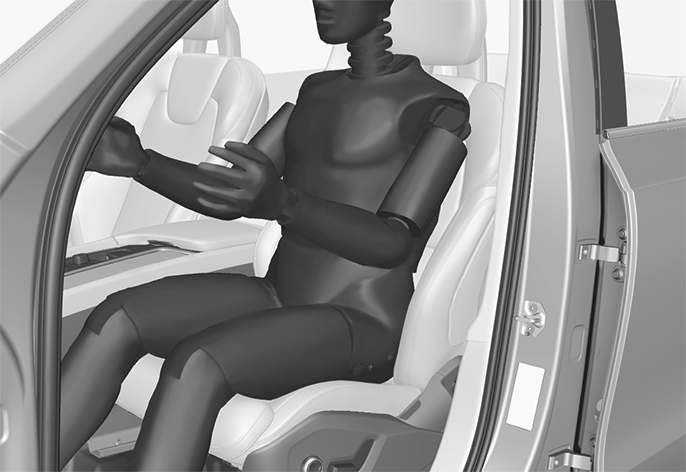
The side airbags are fitted in the outer back-rest frames of the front seats and help to protect the driver and passengers in the front seat.
A sufficiently violent collision trips the sensors and the side airbags are inflated. The airbag inflates between the occupant and the door panel and thereby cushions the initial impact. The airbag deflates when compressed by the collision. The side airbag is normally only deployed on the side of the collision.
WARNING
Volvo recommends that an authorized Volvo workshop should be contacted for repair. Defective work in the side airbag system could cause malfunction and result in serious personal injury.
WARNING
Do not put objects in the area between the outside of the seat and the door panel, since this area is required by the side airbag.
Volvo recommends the use only of car seat covers approved by Volvo. Other seat covers may impede the operation of the side airbags.
WARNING
Side airbags are a supplement the seat-belts. Always use a seatbelt.
Side Airbags and Child Seats
The protection provided by the car to children seated in a child seat or on a booster cushion is not diminished by the side airbag.
Related Information
Inflatable Curtains
The inflatable curtain, Inflatable Curtain (IC), helps to prevent the driver and passengers from striking their heads on the inside of the car during a collision.
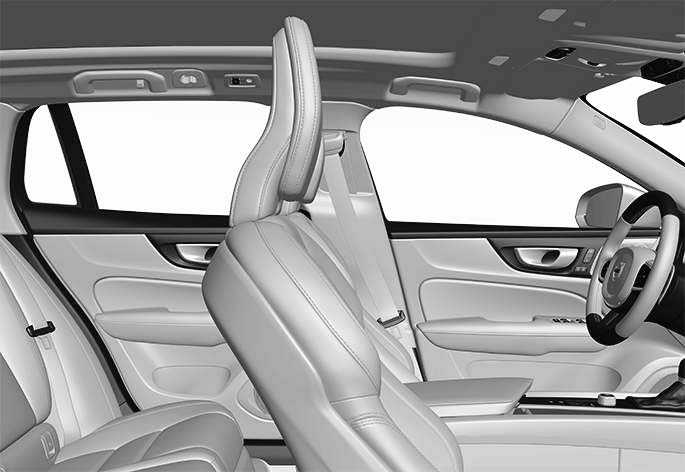
The inflatable curtain is mounted along both sides of the headlining and helps protect the driver and outer seat passengers of the car. The panels are labelled with IC AIRBAG.
A sufficiently violent collision trips the sensors and the inflatable curtain is inflated.
WARNING
Volvo recommends that an authorized Volvo workshop should be contacted for repair. Defective work in the inflatable curtain system can cause malfunction and result in serious personal injury.
WARNING
Never hang or attach heavy items onto the handles in the roof. The hooks are only designed for light coats and jackets (not for solid objects such as umbrellas).
Do not screw or install anything onto the car’s headlining, door pillars or side panels. This could compromise the intended protection. Volvo recommends only using Volvo genuine parts that are approved for fitting within these areas.
WARNING
Leave 10 cm (4 inches) space between the load and the side windows if the car is loaded to above the top edge of the door windows. Otherwise, the intended protection of the inflatable curtain, which is concealed in the headlining, may be compromised.
WARNING
The inflatable curtain is a supplement to the seatbelts. Always use a seatbelt.
Related information
Airbags (p. 55)
Safety mode
Safety mode is a protective state that is triggered when a collision may have damaged any of the car’s vital functions, such as the fuel lines, sensors for any of the safety systems, or the brake system.
If the car has been in a collision, the message Safety mode See Owner’s manual may be shown on the driver display with a warning symbol as long as the display is not damaged and the car’s electrical system is still in working order. This message means that the car has reduced functionality.
WARNING
Never, under any circumstances, attempt to restart the car if it smells of fuel when the Safety mode See Owner’s manual message is shown in the driver display. Leave the car at once.
If the car is in safety mode, it is possible to attempt to reset the system in order to start and move the car for a short distance, if in a dangerous traffic situation for example.
WARNING
Never attempt to repair your car or reset the electronics yourself if the car has been in safety mode. This could result in personal injury or the car not functioning as normal. Volvo recommends engaging an authorised Volvo workshop to check and restore the car to normal status after Safety mode See Owner’s manual has been shown.
WARNING
If the car is in safety mode it must not be towed. It must be transported from its location. Volvo recommends that it is transported to an authorised Volvo work-shop.
Related information
Starting and moving the car after safety mode
If the car is in safety mode, it is possible to attempt to reset the system in order to start and move the car for a short distance, if in a dangerous traffic situation for example.
Starting the car after safety mode
- Check the general damage situation of the car and whether any fuel has been leaking. There must be no smell of fuel either.
If there is only minor damage and a check has revealed no fuel leaks, starting can be attempted.
WARNING
Never, under any circumstances, attempt to restart the car if it smells of fuel when the Safety mode See Owner’s manual message is shown in the driver display. Leave the car at once. - Switch off the car.
- Then try to start the car.
- The car’s electronics carry out a systems check and then try to resume nor-mal status.
IMPORTANT
If the message Safety mode See Owner’s manual is still shown on the display the car must not be driven or towed but a vehicle recovery service must then be used instead. Even if the car appears to be driveable, hidden damage may make the car impossible to control once moving.
Moving the car after safety mode
- If the driver display shows the message Normal mode The car is now in normal mode after a start attempt, the car can be carefully moved if standing in a dangerous position.
- Do not move the car further than necessary.
WARNING
If the car is in safe mode it must not be towed. It must be transported from its location. Volvo recommends that it is transported to an authorised Volvo work-shop.
Related information
Child safety
Children must always sit secure while travelling in the car.
Volvo has child safety equipment (child seats and attachment devices) which is designed for fitting in this particular car. Using Volvo’s child safety equipment, you obtain good conditions for a child to travel safely in the car. In addition, the child safety equipment fits in well and is simple to use. The equipment that should be used is selected taking account of the weight and size of the child.
Volvo recommends that children travel in a rear-facing child seat until as late an age as possible, at least until 4 years of age, and then in a front-facing child seat until the child is 140 cm (4 feet 7 inches) tall.
NOTE
Legal provisions about the type of child seat that must be used for children of different ages and heights vary from country to country. Check what does apply.
NOTE
When using child safety equipment, it is important to read the installation instructions included.
In the event of questions when fitting child safety equipment, contact the manufacturer for clearer instructions.
Children of all ages and sizes must always sit correctly secured in the car. Never allow a child to sit on the knee of a passenger.
Related information
Child seats
Suitable child seats should always be used when children are traveling in the car. Children should sit comfortably and safely. Make sure that the child seat is positioned, mounted and used correctly.
Look in the installation instructions for the child seat for the correct fitting.
NOTE
When using child safety equipment, it is important to read the installation instructions included.
In the event of questions when fitting child safety equipment, contact the manufacturer for clearer instructions.
NOTE
Never leave a child’s seat loose in the car. Always secure it according to the instructions for the child seat, even when it is not in use.
NOTE
Long-term installation and use of child seats may cause wear and tear on the car’s fittings. Volvo recommends using the kick guard accessory to protect the car’s fittings.
Related information
- Child safety (p. 63)
- Upper mounting points for child seats (p. 64)
- Lower mounting points for child seats (p. 65)
- i-Size/ISOFIX mounting points for child seats (p. 66)
- Child seat positioning (p. 66)
- Activating and deactivating passenger air-bag* (p. 58)
Upper mounting points for child seats
The car is equipped with upper mounting points for child seats on the rear seat’s outer seats.
The upper mounting points are primarily intended for use with front-facing child seats.
Always follow the manufacturer’s installation instructions when connecting a child seat to the upper mounting points.
The location of the mounting points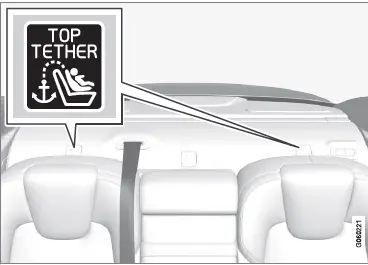
The location of the mounting points is indicated by symbols on the parcel shelf behind the rear seat.
The mounting points are located on the parcel shelf behind the rear seat’s outer seats.
WARNING
The child seat’s upper straps must be routed through the hole in the head restraint leg before they are tensioned at the mounting point. If this is not possible, follow the recommendations from the child seat manufacturer.
NOTE
Fold the head restraints in order to facilitate fitting this type of child seat in cars with folding head restraints on the outer seats.
Related information
- Child seats (p. 64)
- Lower mounting points for child seats (p. 65)
- i-Size/ISOFIX mounting points for child seats (p. 66)
- Overview table for location of child seats (p. 70)
- Table for location of child seats using the car’s seatbelts (p. 71)
Lower mounting points for child seats
The car is equipped with lower mounting points for child seats in the front seat* and the rear seat.
The lower mounting points are designed to be used in conjunction with certain rear-facing child seats.
Always follow the manufacturer’s installation instructions when connecting a child seat to the lower mounting points.
The location of the mounting points
Mounting point locations in the front seat.
The mounting points in the front seat are located on the sides of the passenger seat’s legroom.
The mounting points in the front seat are only mounted if the vehicle is equipped with a switch to activate/deactivate the passenger airbag*.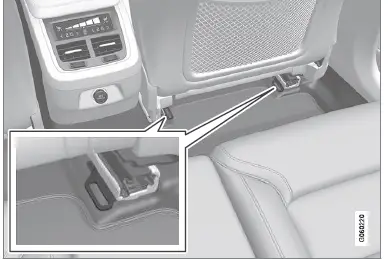
Mounting point locations in the rear seat.
The mounting points in the rear seat are located on the rear section of the front seat’s floor rails.
Related information
- Child seats (p. 64)
Upper mounting points for child seats (p. 64)
i-Size/ISOFIX mounting points for child seats (p. 66) - Overview table for location of child seats (p. 70)
Table for location of child seats using the car’s seatbelts (p. 71)
i-Size/ISOFIX mounting points for child seats
The car is equipped with i-Size/ISOFIX mounting points for child seats in the rear seat.
i-Size/ISOFIX2 is a fixture system for car child seats that is based on an international standard.
Always follow the manufacturer’s installation instructions when connecting a child seat to the i-Size/ISOFIX mounting points.
The location of the mounting points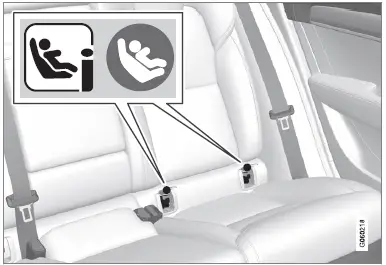
- Mounting point locations are indicated by symbols2 on the upholstery of the backrest.
The mounting points for i-Size/ISOFIX are located behind covers in the lower section of the rear seat’s backrest, in the outer seats.
Lift the covers in order to access the mounting points.
Related information
- Child seats (p. 64)
- Upper mounting points for child seats (p. 64)
- Lower mounting points for child seats (p. 65)
- Overview table for location of child seats (p. 70)
- Table for the location of i-Size child seats (p. 73)
- Table for the location of ISOFIX child seats (p. 74)
Child seat positioning
It is important to position the child seat in the right place in the car. The choice of location depends, amongst other things, on the type of child seat and whether the passenger airbag is activated.
Rear-facing child seat and airbag are not compatible.
Always fit rear-facing child seats in the rear seat if the passenger airbag is activated. If a child is sitting on the front passenger seat then he/she could suffer serious injury if the airbag deploys.
If the passenger airbag is deactivated then rear facing child seats can be fitted on the front passenger seat.
NOTE
Regulations regarding the placement of children in cars vary from country to country. Check what does apply.
WARNING
Never allow anybody to stand or sit in front of the front passenger seat.
Never use a rear-facing child seat on the front passenger seat if the airbag is activated.
Front-facing passengers (children and adults) must never sit on the front passenger seat if the passenger airbag is deactivated.
Failure to follow the advice given above can endanger life or lead to serious personal injury.
Label for passenger airbag
Label on the passenger side’s sun visor.
The warning label for the passenger airbag is positioned as shown above.
Related information
- Child seats (p. 64)
- Child seat mounting (p. 67)
- Overview table for location of child seats (p. 70)
- Table for location of child seats using the car’s seatbelts (p. 71)
- Table for location of i-Size child seats (p. 73)
- Table for location of ISOFIX child seats (p. 74)
Child seat mounting
It is important to remember a number of things when a child restraint system is mounted and used, which depend on where the child restraint system is positioned.
WARNING
Booster cushions/child seats with steel braces or some other design that could rest on the seatbelt buckle’s opening but-ton must not be used, as they could cause the seatbelt buckle to open accidentally.
Do not secure the straps for the child seat into the seat’s horizontal adjustment bar or in springs, rails or beams under the seat. Sharp edges may damage the straps.
Do not allow the upper section of the child seat to rest against the windscreen.
NOTE
When using child safety equipment, it is important to read the installation instructions included.
In the event of questions when fitting child safety equipment, contact the manufacturer for clearer instructions.
NOTE
Never leave a child seat loose in the car. Always secure it according to the instructions for the child seat, even when it is not in use.
NOTE
Long-term installation and use of child seats may cause wear and tear on the car’s fittings. Volvo recommends using the kick guard accessory to protect the car’s fittings.
Installation in the front seat
- When fitting rear-facing child seats, check that the passenger airbag is deactivated.
- When fitting front-facing child seats, check that the passenger airbag is activated.
Only use child seats that are recommended by Volvo, are universally approved or are semi-universal, and where the car is included on the manufacturer’s vehicle list.
ISOFIX child seats can only be fitted when the car is equipped with the ISOFIX con-sole3 accessory. - If the child seat is equipped with lower straps, Volvo recommends that the lower mounting points are used with these3.
- If the child seat is equipped with support legs, always fit the support leg/support legs directly to the floor. Never fit a sup-port leg to a footrest or other object.
Installation in the rear seat
- Only use child seats that are recommended by Volvo, are universally approved4 or are semi-universal, and where the car is included on the manufacturer’s vehicle list.
A child seat with support legs must not be fitted in the centre seat.
The outer seats are equipped with the ISOFIX fixture system and are approved for i-Size5.
The outer seats are equipped with upper mounting points. Volvo recommends that child seat’s upper straps should be pulled through the hole in the head restraint before being tensioned at the mounting point. If this is not possible, follow the recommendations from the child seat manufacturer. - If the child seat is equipped with lower straps, never adjust the position of the seat in front after the straps have been fit-ted in the lower mounting points. Always remember to remove the lower straps when the child seat is not installed.
- If the child seat is equipped with support legs, always fit the support leg/support legs directly to the floor. Never fit a sup-port leg to a footrest or other object.
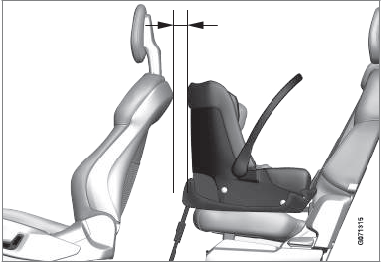
With the installation of an infant seat in the rear seat, Volvo recommends a distance of at least 50 mm
(2 tum) from the front part of the infant seat to the rearmost part of the seat in front.
Related information
- Child seat positioning (p. 66)
- Overview table for location of child seats (p. 70)
- Table for location of child seats using the car’s seatbelts (p. 71)
- Table for location of i-Size child seats (p. 73)
- Table for location of ISOFIX child seats (p. 74)
Overview table for location of child seats
The table gives an overview of the types of child seats suitable for the car’s seats.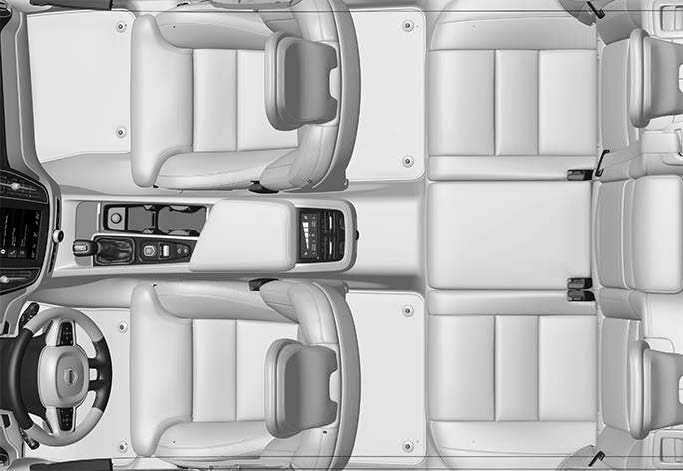
Seat positions in left-hand drive cars.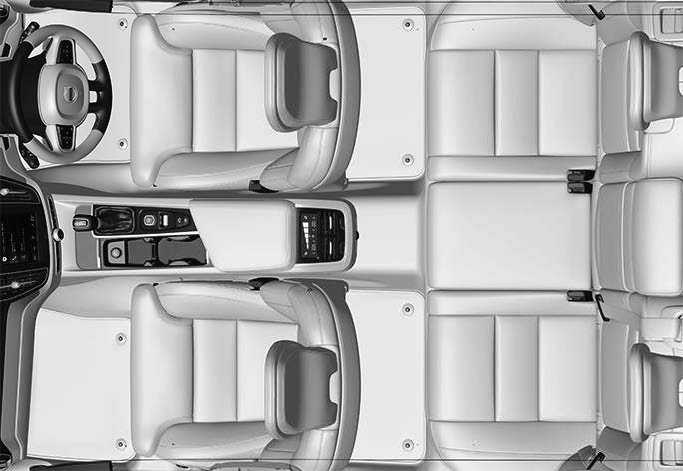
Seat positions in right-hand drive cars.
| i-Size child seats | Universally approved child seats secured using the car’s seatbelt | Other child seat categoriesA | |
| Seat position B | 3, 5 | 2C, 3, 5 | 2C, 3, 4, 5 |
- For more information, contact the child seat manufacturer.
According to the numbering above.
Activated airbag for front-facing child seats. Deactivated airbag for rear-facing child seats.
Related information
- Child seat positioning (p. 66)
- Child seat mounting (p. 67)
- Table for the location of child seats using the car’s seatbelts (p. 71)
- Table for the location of i-Size child seats (p. 73)
- Table for the location of ISOFIX child seats (p. 74)
Table for the location of child seats using the car’s seatbelts
The table gives a recommendation for which child seat suits which locations, and for what size of the child.
NOTE
Always read the owner’s manual section on installing a child seat before installing one in the car.
| Weight | Front seat (with deactivated airbag, only rear-facing child seats)A | Front seat (with activated airbag, only front-facing child seats)A | Outer rear seat | Centre rear seat |
| Group 0
max 10 kg |
UB, C |
X |
UC |
LC |
| Group 0+
max 13 kg |
UB, C |
X |
UC |
LC |
| Group 1
9-18 kg |
LD |
UFB, E |
UE, LD |
LE |
| Group 2
15-25 kg |
LD |
UFB, F |
UF, LD |
LF |
| Weight | Front seat (with deactivated airbag, only rear-facing child seats)A | Front seat (with activated airbag, only front-facing child seats)A | Outer rear seat | Centre rear seat |
| Group 3
22-36 kg |
X |
UFB, F |
UF |
LF |
| U: Suitable for universal category restraints approved for use in this mass group. UF: Suitable for front-facing universally approved child seats. L: Suitable for particular child restraints. These restraints may be of the specific vehicle, restricted or semi-universal categories. X: The seat is not suitable for children in this mass group. |
||||
- The seat cushion extension must always be retracted for the installation of child seats.
- Adjust the backrest to a more upright position.
- Volvo recommends: Volvo infant seat (type approval E1 04301146).
- Volvo recommends: Volvo rear-facing seat (type approval E5 04212).
- Volvo recommends rear-facing child seat for children in this mass group.
- Volvo recommends: Booster cushion with and without back (type approval E5 04216); Volvo booster seat (type approval E1 04301312).
WARNING
Never use a rear-facing child seat on the front passenger seat if the passenger air-bag is activated.
Related information
- Child seat positioning (p. 66)
- Child seat mounting (p. 67)
- Overview table for location of child seats (p. 70)
- Table for location of i-Size child seats (p. 73)
- Table for location of ISOFIX child seats (p. 74)
- Seatbelts (p. 50)
Table for location of i-Size child seats
The table gives a recommendation for which i-Size child seats suit which locations, and for what size of child.
The child seat must be approved in accordance with UN Reg R129.
NOTE
Always read the owner’s manual section on installing a child seat before installing one in the car.
| Type of child seat | Front seat (with deactivated airbag, only rear-facing child seats) | Front seat (with activated airbag, only front-facing child seats) | Outer rear seat | Centre rear seat |
| i-Size child seats | X | X | i-UA, B | X |
| i-U: Suitable for i-Size “universal” child seat, front-facing and rear-facing. X: Not suitable for universally approved child seats. |
||||
A Volvo recommends that children travel in a rear-facing child seat until as late an age as possible, at least until 4 years of age. B Volvo recommends: BeSafe iZi Kid X2 i-Size (type approval E4-129R-000002).
Related information
- Child seat positioning (p. 66)
- Child seat mounting (p. 67)
- Overview table for location of child seats (p. 70)
- Table for location of child seats using the car’s seatbelts (p. 71)
- Table for location of ISOFIX child seats (p. 74)
- i-Size/ISOFIX mounting points for child seats (p. 66)
Table for location of ISOFIX child seats
The table gives a recommendation for which ISOFIX child seats suit which locations, and for what size of child.
The child seat must be approved in accordance with UN Reg R44 and the car model must be included in the manufacturer’s vehicle list.
NOTE
Always read the owner’s manual section on installing a child seat before installing one in the car.
-
Weight Size classA Type of child seat Front seat (with deactivated airbag, only rear- facing child seats)B, C Front seat (with activated airbag, only front-facing child seats)B, C Outer rear seat Centre rear seat Group 0 max 10 kg
E
Rear-facing infant seat
ILB, D, XE
X
ILD
X
Group 0+
max 13 kg
E Rear-facing infant seat ILB, D, F, XE
X
ILD
X
C Rear-facing child seat D Rear-facing child seat -
Weight Size classA Type of child seat Front seat (with deactivated airbag, only rear- facing child seats)B, C Front seat (with activated airbag, only front-facing child seats)B, C Outer rear seat Centre rear seat Group 1
9-18 kg
A Front-facing child seat X
ILB, F, G, XE
ILG, IUFG
X
B Front-facing child seat B1 Front-facing child seat C Rear-facing child seat ILB, F, XE
X
IL
X
D Rear-facing child seat IL: Suitable for particular ISOFIX child restraint systems. These child restraint systems are those of the specific vehicle, restricted or semi-universal categories.
IUF: Suitable for ISOFIX forward child restraint systems of universal category approved for use in the mass group. X: Not suitable for ISOFIX child restraint systems. - For child seats with the ISOFIX fixture system there is a size classification to help users choose the right type of child seat. The size class can be read on the child seat’s label.
Works for the installation of ISOFIX child seats that are semi-universally approved (IL) if the car is equipped with the ISOFIX console accessory (the accessory range varies depending on market).
There are no upper mounting points for child seats here.
The seat cushion extension must always be retracted for the installation of child seats. - Volvo recommends: Volvo infant seat secured using the ISOFIX fixture system (type approval E1 04301146).
- Applicable if the car is not fitted with an ISOFIX bracket.
- Adjust the backrest so that the head restraint does not interfere with the child seat.
- Volvo recommends rear-facing child seat for children in this mass group.
WARNING
Never use a rear-facing child seat on the front passenger seat if the passenger air-bag is activated.
NOTE
If an i-Size/ISOFIX child seat has no size classification, the car model must be included on the vehicle list for the child seat.
NOTE
Volvo recommends contacting an authorised Volvo dealer for information about which i-Size/ISOFIX child seats Volvo recommends.
Related information
- Child seat positioning (p. 66)
- Child seat mounting (p. 67)
- Overview table for location of child seats (p. 70)
- Table for location of child seats using the car’s seatbelts (p. 71)
- Table for location of i-Size child seats (p. 73)
- i-Size/ISOFIX mounting points for child seats (p. 66)
Detail information for child seat manufacturers
The table provides detailed information for child seat manufacturers on which locations in the car are appropriate for which types of child seat.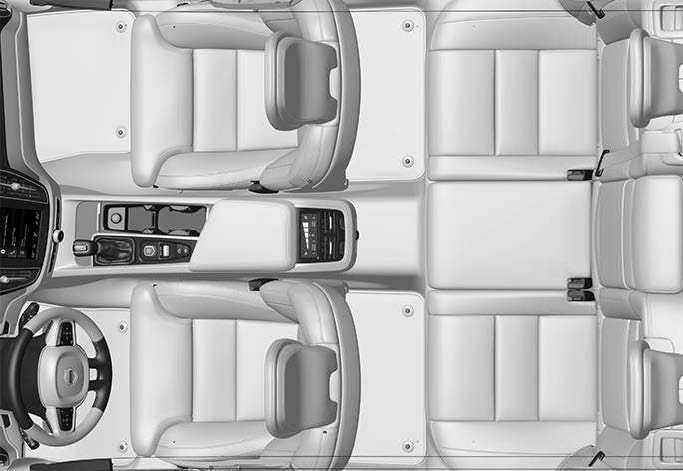
Seat positions in left-hand drive cars.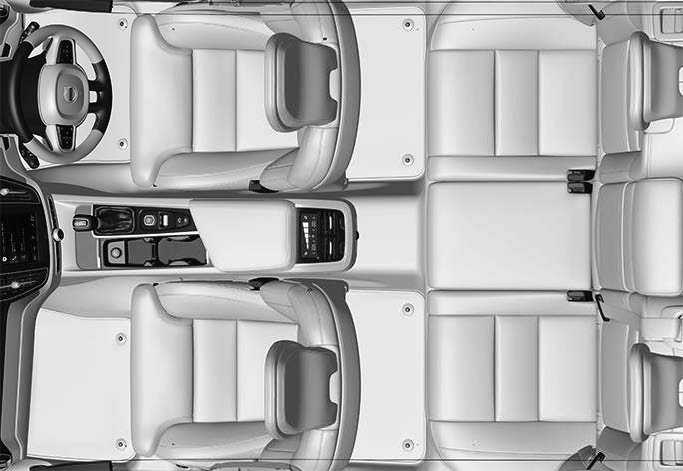
Seat positions in right-hand drive cars.
| Seat positionA | 1 | 2 (with deactivated airbag, only rear-facing child seats)B, C | 2 (with activated air- bag, only front-facing child seats)B, C | 3 | 4D | 5 |
| Seat position suitable for universal category restraints which are attached using the car’s seatbelt (Yes/No). | No | YesE | YesE | Yes | No | Yes |
| Seat position for i-Size (Yes/No) | No | No | No | Yes | No | Yes |
| Seat position lateral fixture (L1/L2/No) | No | No | No | No | No | No |
| Largest suitable rearward facing fixture (R1/R2/R3/No) | No | R3F | No | R3 | No | R3 |
| Seat positionA | 1 | 2 (with deactivated airbag, only rear-facing child seats)B, C | 2 (with activated air- bag, only front-facing child seats)B, C | 3 | 4D | 5 |
| Largest suitable forward facing fixture (F1/F2/F2x/F3/No) | No | No | F3 | F3 | No | F3 |
| Largest suitable booster fixture (B2/B3/No) | No | No | B3 | B3 | No | B3 |
- In accordance with illustration.
- The seat cushion extension must always be retracted for the installation of child seats.
- A child seat with support legs can be used on this seat.
- A child seat with support legs cannot be used on this seat.
- Adjust the backrest to a more upright position.
- Works for the installation of ISOFIX child seats that are semi-universally approved (IL) if the car is equipped with the ISOFIX console accessory (the accessory range varies depending on market).
Upper mounting points for child seats are not available for this seat.
FAQ
A1: The Volvo S60 for the model years 2021 to 2023 includes a range of advanced safety features such as Collision Avoidance Assistance, Lane Keeping Aid, and Road Sign Information.
A2: Yes, the Volvo S60 is equipped with automatic emergency braking as part of its safety suite to help prevent or mitigate collisions.
A3: City Safety is Volvo’s collision avoidance system that helps detect pedestrians, cyclists, and other vehicles, and can apply brakes to avoid or reduce the impact of a collision.
A4: Yes, the Volvo S60 is equipped with various driver-assistance features like adaptive cruise control, blind-spot monitoring, and rear cross-traffic alert.
A5: Yes, the Volvo S60 features a standard rearview camera to assist with parking and reversing.
A6: Yes, the Volvo S60 is equipped with a lane departure warning system that alerts the driver if the vehicle unintentionally drifts out of its lane.
A7: Yes, some models of the Volvo S60 offer features like Driver Alert Control, which monitors driver behavior and provides alerts if signs of fatigue are detected.
A8: Yes, the Volvo S60 is equipped with a comprehensive airbag system that includes front, side, and curtain airbags for all passengers.
A9: Yes, some models of the Volvo S60 feature adaptive headlights that adjust their direction to follow the steering wheel and provide better visibility around curves.
A10: Yes, the Volvo S60 is equipped with a pedestrian detection system that can help prevent collisions with pedestrians and cyclists.
A11: Yes, the Volvo S60 features a blind-spot monitoring system that alerts the driver when a vehicle is in their blind spot.
A12: Yes, the Volvo S60 often includes automatic high beams that adjust the headlight intensity based on surrounding traffic conditions.
A13: Yes, the Volvo S60 features a forward collision warning system that alerts the driver if a potential collision with another vehicle or obstacle is detected.
A14: Yes, the Volvo S60 includes child safety features such as rear door child locks, LATCH anchors, and optional integrated booster seats.
A15: Yes, some models of the Volvo S60 offer active park assist, a feature that helps the driver parallel park the vehicle.
-
Useful Link
- View Full PFD: Volvo S60 2021-2023 User Manual | Autouser Guide
Volvo S60 2021-2023 Windows, Glass and Mirrors User Manua

